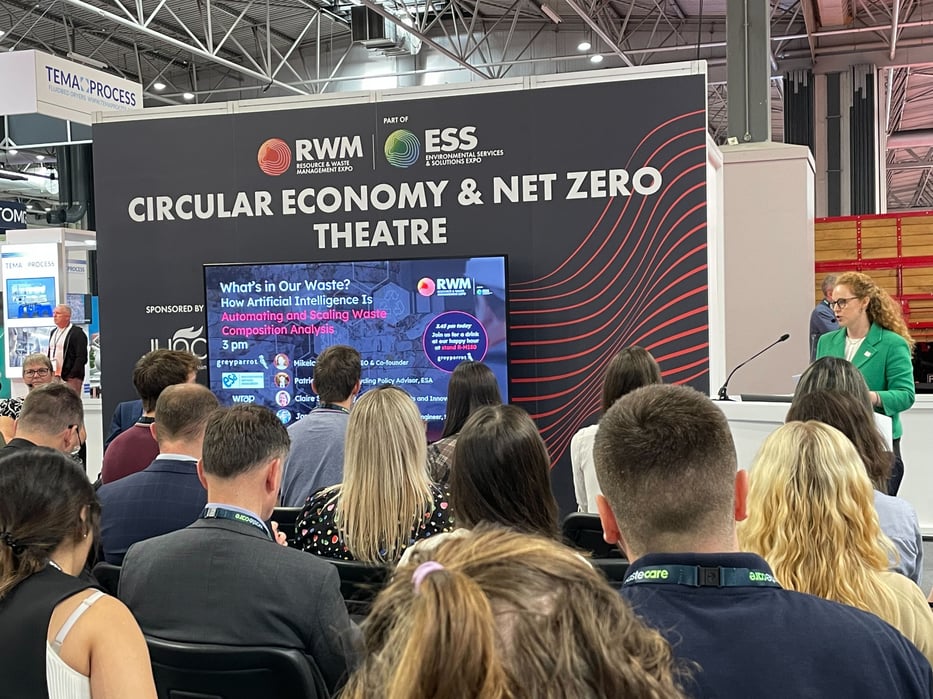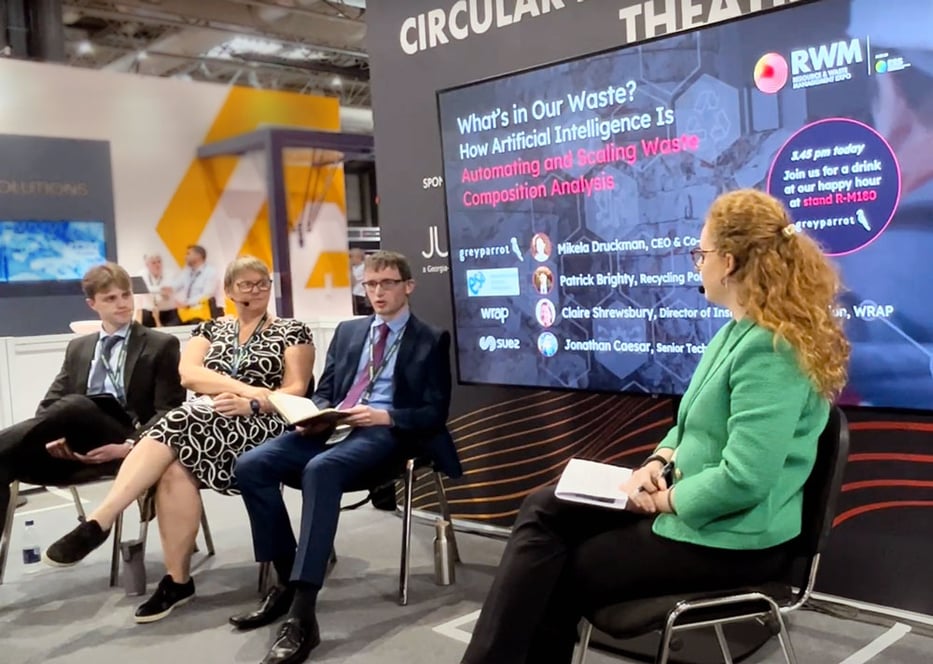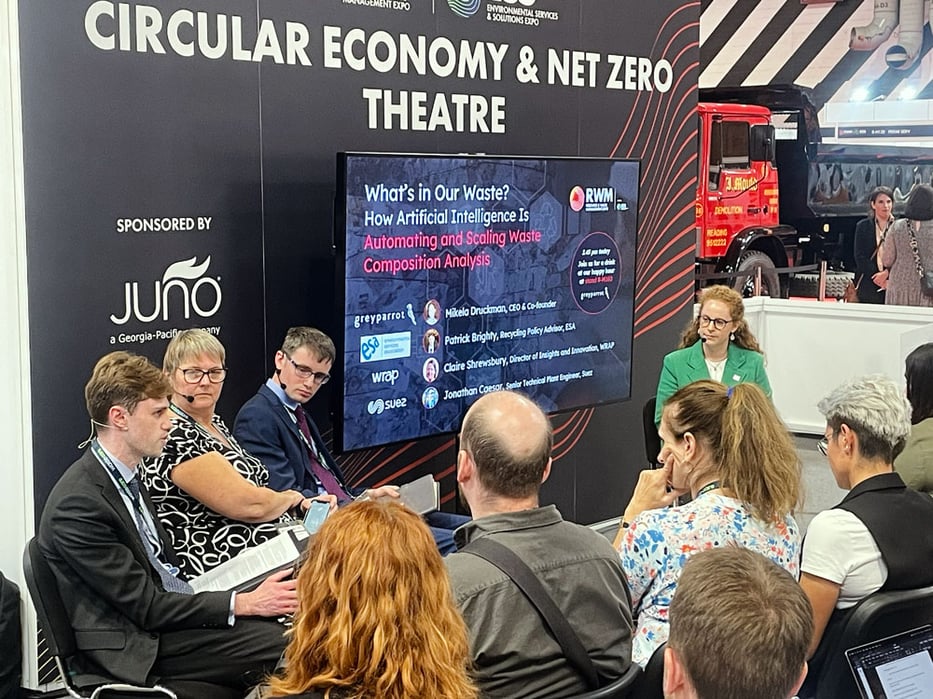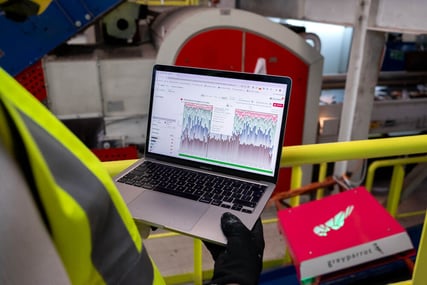On day one of this year’s RWM conference, our CEO and co-founder Mikela Druckman chaired a panel discussion to address one of the recycling and waste sector’s most pressing challenges:
“Less than 1% of the waste we process, we measure - that information drives policy, drives operation, drives trade — even consumer behaviour.”
Mikela Druckman, CEO and co-founder of Greyparrot
Mikela was joined by WRAP’s Claire Shrewsbury, SUEZ UK’s Jonathan Caesar and The Environmental Service Association’s (ESA) Patrick Brighty to talk about the urgent need for a scalable sampling solution to meet regulatory requirements.
Reflecting on progress
Mikela began by reflecting on the twelve months leading up to this year’s expo:
“I’m proud to say that we now process over 25 billion waste objects every year. Last year, I chaired a panel about the waste data drought. It’s good to see that since then, we’ve gathered a lot more data.”
Mikela Druckman, Greyparrot
Since RWM 2022, artificial intelligence has driven a major leap in our understanding of waste material. The data challenge has since evolved: the technology has developed just in time to help meet the sampling requirements of policies like extended producer responsibility (EPR).
Now, it’s a matter of agreeing on what adoption should look like.

Outlining new waste tracking requirements
EPR, the Emissions Trading System (ETS) and next year’s material facility regulations were the focus of debates across the entire expo. Policy developments were welcomed, but they also presented a level of uncertainty that Patrick Brighty — the ESA’s Recycling Policy Advisor — highlighted:
“The enhanced sampling and reporting regime really underpins EPR, and will inform the distribution of over a billion pounds a year worth of local authority payments.
It’s going to put significant stress on facilities across the sector. We conducted a survey of our members, and one of the key findings was that 50% of MRFs lack the space to meet [new] sampling requirements.”
Patrick Brighty, Recycling Policy Advisor at the ESA
As WRAP’s Director of Insights and Innovation, Claire Shrewsbury confirmed the gravity of the changes, and the growing importance of comprehensive waste data:
”There is going to be a huge burden from an EPR perspective. Having accurate data will be really important to support things like fees and payments for EPR.”
Claire Shrewsbury, Director of Insights and Innovation at WRAP
From the ESA’s perspective, new methods for collecting that data need to be built into policy from the outset:
"It’s hugely important…that we generate good waste composition data. We see AI as part of a suite of solutions to help tackle this, and certainly want to see the development of regulation that really empowers its inclusion in the waste sector."
Patrick Brighty, ESA
Against the backdrop of major policy change, scalable data collection will soon be vital. With the regulatory challenge outlined, the panel turned to AI’s practical role in helping facilities gather more information about their material - while enhancing operations.

AI in the recovery facility
As a Senior Technical Plant Engineer for Suez, Jonathan Caesar was able to offer an on-the-ground perspective on the exponential increase in data collection offered by AI waste analytics:
“The ability of AI analytics to automatically monitor all the material in a processing stream sets it apart from conventional composition analysis.
Spot sampling generally covers less than 1% of the material that’s processed. With AI analytics, you’re essentially able to monitor all of the material over a material stream. There’s a stark contrast there.”
Jonathan Caesar, Senior Technical Plant Engineer at SUEZ UK
It’s a crucial consideration for waste transfer stations, as well. ESA research has determined that many will fall within new sampling regulation, but few are able to accommodate such a change:
“They don’t have dedicated areas for sampling. To maintain health and safety, they’ll probably have to stop traffic coming into the facility for manual sampling. Obviously that’s going to have cost implications.”
Patrick Brighty, ESA
That increased coverage doesn’t just address new regulatory demand. As an early adopter of AI waste analytics, Jonathan has already begun to make connections between a greater understanding of material and the performance goals of his facilities.
Citing the ability to learn more about food-grade status and item counts, the possibilities of multi-stream monitoring and the reduction of human bias, he views the technology as a transformative tool:
“The most important aspect for me is how it can be used to optimise facilities, so that we can increase the amount…and purity…of the material that’s recovered.”
Jonathan Caesar, SUEZ UK
Encouraging change beyond the facility
As a strategist with a birds-eye-view of the entire recycling ecosystem, Claire expanded on Jonathan’s perspective, sharing her thoughts on the utility of waste data beyond new compliance requirements and sorting efficiency:
“I think data will help us maximise our efforts in the right places. It’s got the possibility to help influence behaviours, and how we encourage behaviours. If we’re not seeing certain materials or products in the waste stream that we should be seeing, then we can turn on different campaigns…having that intelligence will be really important.”
Claire Shrewsbury, WRAP
At Greyparrot, we’ve seen major potential for behaviour change at the very top of the value chain, with packaging design:
“What we’ve seen is that when you talk to retailers, or brand owners, they think their product is recyclable, but the reality on the ground is very different.”
Mikela Druckman, Greyparrot
It’s a challenge that the WRAP team have identified, too:
“[Data] will help us have those conversations about why something isn’t being sorted.
For something to be truly recyclable, it has to be collected, sorted, sent somewhere to be processed into another material, and then it actually has to be used again.”
Claire Shrewsbury, WRAP

Looking to waste tracking's future
For many in the waste sector, the full potential of detailed AI analytics is still coming into focus.
Policy changes present an immediate use-case, but Mikela took the opportunity to ask Claire, Patrick and Jonathan what they hoped the technology would achieve by next year’s expo.
Patrick and the ESA will be facing the arrival of material facility regulations by that time, and his answer reflected that approaching deadline:
"If the burden is shifting as much as we expect it to, more development of bespoke AI for those new, in-scope facilities — particularly…waste transfer stations — would be really exciting."
Patrick Brighty, ESA
For Claire, the new waste data challenge is industry-wide standardisation, and recognition from policy-makers:
“I’d hope to see an agreement about what an AI sampling will look like, so there’s confidence that it meets the requirements for the EA and other regulators.
We need a recognised standard of what it needs to be delivering.”
Claire Shrewsbury, WRAP
Jonathan looked to the recovery facility of the future, envisioning plants that have continuous monitoring built in from the design stage — both to meet sampling requirements, and increase resource recovery:
“I’d like to see a plant that is designed thinking about how best to use AI analytics from the outset. It would be great to see a plant that is dynamically controlled using AI. One that uses the information that comes out of artificial intelligence to actually influence the plant to improve performance.”
Jonathan Caesar, SUEZ UK
Mikela herself is optimistic about the future of AI’s relationship with policy. In her prediction for the future of waste data, she echoed a common theme across RWM 2023 — the difficulty presented by unclear regulations, and the benefits that will come with concrete action:
“We were sitting here last year talking about the waste data drought. Now, we’re starting to have a significant amount of data, and these solutions are being adopted more and more.
We’ve seen a lot of the conversation being driven by the industry, who is asking for [automation]. We’re in a policy ‘grey zone’, but I think their position on AI waste analytics and data will accelerate in the year to come.”
Mikela Druckman, Greyparrot

.png?width=780&height=532&name=Screenshot%202023-09-18%20at%2011.52.08%20(1).png)


.png?width=501&height=285&name=IMG_6004%20(1).png)